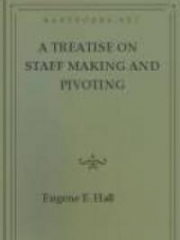The turning up of a new pivot does not differ in any way from the instructions given for turning pivots on a new staff. With a little care both in turning and finishing, a new pivot can be put in so nicely that only the initiated can tell it, and then only with the aid of a strong gla.s.s.
In pivoting cylinders there is some danger of breaking them. To avoid this, select a piece of joint wire, the opening of which is slightly larger than the diameter of the cylinder at the lower end, and cut off a piece the length of the cylinder proper, leaving the pivot projecting.
Now fill the cylinder with lathe wax, and while the wax is warm, slip on the joint wire. You can now proceed to true up the pivot in the usual manner, and when the wax is quite cold, proceed to turn and polish the pivot before removing from the lathe. If the joint wire is properly cemented on the cylinder, it is almost impossible to break it. After all the work is done, the wax can be dissolved in alcohol. In pivoting pinions to cylinder escape-wheels and third wheels, it is not necessary to remove the wheels, but great care should be used in handling. In the latter case use plenty of wax. Do all your centering by the outside of the pinion. Perfect centering and sharp tools are requisite to good pivoting. Do not try to rush your work, especially while drilling.
Proceed deliberately with your work and aim to restore the watch to the condition it was in originally, and you will find staffing and pivoting is not half as hard as some workmen would have you believe.
[Footnote A: POISING THE BALANCE, by J. L. Finn, Geo. K. Hazlitt & Co., publishers, Chicago.]
 A Treatise on Staff Making and Pivoting
A Treatise on Staff Making and Pivoting